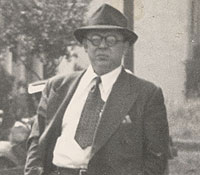A
COMMEMORATIVE WWII HISTORY SERIES:
Part 4: The Case of the Mysterious Russian Letter
08/26/05
 |
Vasilli Zubilin |
On August 7, 1943—62
years ago this month—FBI Headquarters received an anonymous typewritten
letter in Russian. Our interest was piqued, and we quickly translated
the letter.
Talk about
intrigue: the writer accused more than ten Soviet diplomats
in the U.S. of being spies, including the Soviet Vice-Consuls in San
Francisco and New York and the Second Secretary of the Soviet Embassy
in Washington—Vasilli Zubilin.
The charges were hard
to believe. The Russians—our country's allies in World
War II—spying on the U.S.?
At the time, we'd
only just begun investigating the extent of Soviet operations here. Our
resources were heavily dedicated to Axis espionage and sabotage cases.
Now, this
letter. What to make of it? Parts of it were strange and unbelievable,
but other parts confirmed things we already knew or suspected. It was
clear that its author was well versed in Soviet intelligence in the
U.S. and credible.
For example, four
months earlier, our agents had learned that Zubilin had spoken with—and
slipped money to—a Communist Party official named Steve Nelson.
Zubilin's aim? To infiltrate a Berkeley, California, lab doing work for
the Manhattan Project, America's secret atomic bomb program. We passed
what we learned about Zubilin's spying to the War Department, which had
primary investigative jurisdiction on the project. After the war ended,
we would investigate other, more serious attempts to steal U.S. A-bomb
secrets, but that's another
story.
In the meantime,
we had a predicate to take a closer look at Soviet espionage. We
launched a major investigation to discover the potential interrelationships
of Soviet diplomats, the Communist Party of the United States, and
the Communist International party, also called the "Comintern." Through
the case—called COMRAP, for "Comintern Appartus"—we
learned that the extent of Soviet spying was significant.
The upshot? We
were more prepared for the Cold War to come. In the next few years and
beyond, the FBI and its intelligence partners identified hundreds of
Soviet spies and helped protect vital American secrets from coast to
coast.
Resources:


